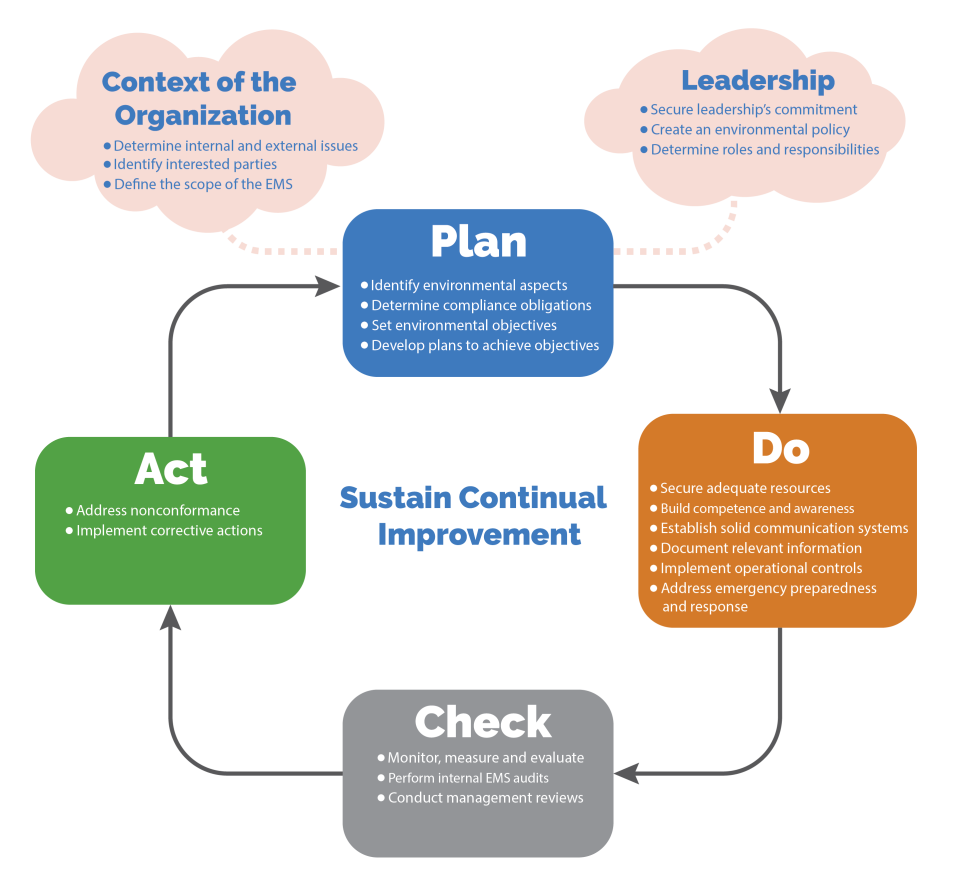EMS Under ISO 14001
An EMS encourages an organization to continuously improve its environmental performance by having its system follow a repeating cycle as described in the image below.

The organization first commits to an environmental policy, then uses its policy as a basis for establishing a plan which sets objectives and targets for improving environmental performance. The next step is implementation. After that, the organization evaluates its environmental performance to see whether the objectives and targets are being met. If targets are not being met, corrective action is taken. The results of this evaluation are then reviewed by top management to see if the EMS is working. Management revisits the environmental policy and sets new targets in a revised plan. The company then implements the revised plan. The cycle repeats, and continuous improvement occurs.
The most commonly used framework for an EMS is the one developed by the International Organization for Standardization (ISO) for the ISO 14001 standard. Established in 1996, this framework is the official international standard for an EMS which is based on the Plan-Do-Check-Act methodology. The five main stages of an EMS, as defined by the ISO 14001 standard, are described below:
1. Commitment and Policy - Top management commits to environmental improvement and establishes the organization's environmental policy. The policy is the foundation of the EMS.
2. Planning - An organization first identifies environmental aspects of its operations. Environmental aspects are those items, such as air pollutants or hazardous waste, that can have negative impacts on people and/or the environment. An organization then determines which aspects are significant by choosing criteria considered most important by the organization. For example, an organization may choose worker health and safety, environmental compliance, and cost as its criteria. Once significant environmental aspects are determined, an organization sets objectives and targets. An objective is an overall environmental goal (e.g., minimize use of chemical X). A target is a detailed, quantified requirement that arises from the objectives (e.g., reduce use of chemical X by 25% by September 2030). The final part of the planning stage is devising an action plan for meeting the targets. This includes designating responsibilities, establishing a schedule, and outlining clearly defined steps to meet the targets.
3. Implementation - A organization follows through with the action plan using the necessary resources (human, financial, etc.). An important component is employee training and awareness for all employees (including interns, contractors, etc.). Other steps in the implementation stage include documentation, following operating procedures, and setting up internal and external communication lines.
4. Evaluation - A company monitors its operations to evaluate whether objectives and targets are being met. If not, the company takes corrective action.
5. Review - Top management reviews the results of the evaluation to see if the EMS is working. Management determines whether the original environmental policy is consistent with the organization's values. The plan is then revised to optimize the effectiveness of the EMS. The review stage creates a loop of continuous improvement for a company.
